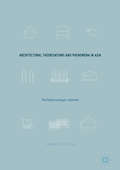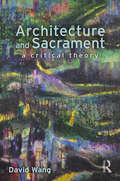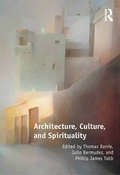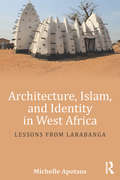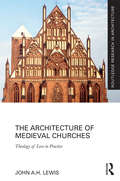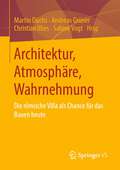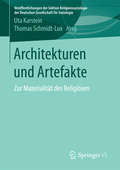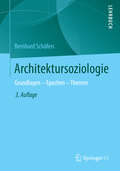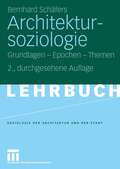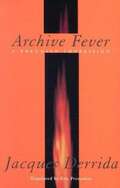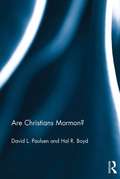- Table View
- List View
Architects of Piety: The Cappadocian Fathers and the Cult of the Martyrs
by Vasiliki M. LimberisThis book provides a new way of understanding the role of the cult of the martyrs for the Cappadocian Fathers and their families. The study shows that the cult of the martyrs was so popular among all social levels of Christians, including the Cappadocian Fathers, that it formed the rudimentary framework for Christian piety in the fourth century. When Christianity became the state religion in 325, the fundamental presupposition of martyrdom as Christian identity became ambiguous. Thus it was paramount for the Cappadocians to preserve, evolve, and represent how martyr piety fit into the Christian life after the Constantinian settlement. The book reveals the Cappadocians' tireless promotion of martyr piety through careful expositions of the ritual of the panegyris and importance of the calendar, their pastoral teachings through panegyrics to the martyrs, and the triumphs and frustrations of building a martyrium. Limberis also demonstrates how the Cappadocians fixed the image of the martyrs on their families' identities forever, showing how the veneration of the martyrs contributed to practicing Christian faith in a familial context. The study demonstrates that the local martyr cults were so powerful that the Cappadocian Fathers promoted their own kin as martyrs, and claimed other martyrs as their ancestors. The study also engages how gender and theories of kinship complicate their texts, both for the Cappadocians and for us.
Architects of Piety: The Cappadocian Fathers and the Cult of the Martyrs
by Vasiliki M. LimberisThis book provides a new way of understanding the role of the cult of the martyrs for the Cappadocian Fathers and their families. The study shows that the cult of the martyrs was so popular among all social levels of Christians, including the Cappadocian Fathers, that it formed the rudimentary framework for Christian piety in the fourth century. When Christianity became the state religion in 325, the fundamental presupposition of martyrdom as Christian identity became ambiguous. Thus it was paramount for the Cappadocians to preserve, evolve, and represent how martyr piety fit into the Christian life after the Constantinian settlement. The book reveals the Cappadocians' tireless promotion of martyr piety through careful expositions of the ritual of the panegyris and importance of the calendar, their pastoral teachings through panegyrics to the martyrs, and the triumphs and frustrations of building a martyrium. Limberis also demonstrates how the Cappadocians fixed the image of the martyrs on their families' identities forever, showing how the veneration of the martyrs contributed to practicing Christian faith in a familial context. The study demonstrates that the local martyr cults were so powerful that the Cappadocian Fathers promoted their own kin as martyrs, and claimed other martyrs as their ancestors. The study also engages how gender and theories of kinship complicate their texts, both for the Cappadocians and for us.
Architectural Theorisations and Phenomena in Asia: The Polychronotypic Jetztzeit
by Francis Chia-Hui LinThis book is the first overall and detailed discussion of contemporary Asia’s architectural theorisations and phenomena based on its heteroglossic and decolonisation character. Lin presents a theoretical journey of transdisciplinary reflection upon contemporary Asia’s pragmatic phenomena which is methodologically achieved by means of elaborations of how tangible Asian architecture can be philosophically theorised and how interchangeable architectural theory is practically ‘Asianised’. Discussions in the book are critically integrated with comparative studies focused on Japan, Taiwan, China, Hong Kong, Singapore, Malaysia, Australia, New Zealand and the UK. These empirical examinations are highlights of phenomenal localities, architecture, cities and cultures which reference the historicity of the Asia Pacific, Asia’s contemporary architectural situations, and their subtle relationship with the ‘West’. The schematisation of intended ‘fuzziness’ for Asia and its architecture is framed as the notion polychronotypic jetztzeit to represent a present time-place context of contemporary Asian architecture and urbanism. This book will be of great interest to scholars of Asian Studies, Architectural Studies, Postcolonial Studies, Urban Studies and Cultural Studies.
Architectural Theorisations and Phenomena in Asia: The Polychronotypic Jetztzeit
by Francis Chia-Hui LinThis book is the first overall and detailed discussion of contemporary Asia’s architectural theorisations and phenomena based on its heteroglossic and decolonisation character. Lin presents a theoretical journey of transdisciplinary reflection upon contemporary Asia’s pragmatic phenomena which is methodologically achieved by means of elaborations of how tangible Asian architecture can be philosophically theorised and how interchangeable architectural theory is practically ‘Asianised’. Discussions in the book are critically integrated with comparative studies focused on Japan, Taiwan, China, Hong Kong, Singapore, Malaysia, Australia, New Zealand and the UK. These empirical examinations are highlights of phenomenal localities, architecture, cities and cultures which reference the historicity of the Asia Pacific, Asia’s contemporary architectural situations, and their subtle relationship with the ‘West’. The schematisation of intended ‘fuzziness’ for Asia and its architecture is framed as the notion polychronotypic jetztzeit to represent a present time-place context of contemporary Asian architecture and urbanism. This book will be of great interest to scholars of Asian Studies, Architectural Studies, Postcolonial Studies, Urban Studies and Cultural Studies.
Architecture and Sacrament: A Critical Theory
by David WangDavid Wang’s Architecture and Sacrament considers architectural theory from a Christian theological perspective, specifically, the analogy of being (analogia entis). The book tracks social and cultural reasons why the theological literature tends to be separate from contemporary architecture theory. Wang argues that retrieval of the sacramental outlook embedded within the analogy of being, which informed centuries of art and architecture in the West, can shed light on current architectural issues such as "big box stores," the environmental crisis and the loss of sense of community. The book critiques the materialist basis of current architectural discourse, subsumed largely under the banner of critical theory. This volume on how European ideas inform architectural theory complements Wang’s previous book, A Philosophy of Chinese Architecture: Past, Present, Future, and will appeal to architecture students and academics, as well as those grappling with the philosophical moorings of all built environments.
Architecture and Sacrament: A Critical Theory
by David WangDavid Wang’s Architecture and Sacrament considers architectural theory from a Christian theological perspective, specifically, the analogy of being (analogia entis). The book tracks social and cultural reasons why the theological literature tends to be separate from contemporary architecture theory. Wang argues that retrieval of the sacramental outlook embedded within the analogy of being, which informed centuries of art and architecture in the West, can shed light on current architectural issues such as "big box stores," the environmental crisis and the loss of sense of community. The book critiques the materialist basis of current architectural discourse, subsumed largely under the banner of critical theory. This volume on how European ideas inform architectural theory complements Wang’s previous book, A Philosophy of Chinese Architecture: Past, Present, Future, and will appeal to architecture students and academics, as well as those grappling with the philosophical moorings of all built environments.
Architecture and Silence (Routledge Research in Architecture)
by Christos P. KakalisThis book explores the role of silence in how we design, present and experi-ence architecture. Grounded in phenomenological theory, the book builds on historical, theoretical and practical approaches to examine silence as a methodological tool of architectural research and unravel the experiential qualities of the design process. Distinct from an entirely soundless experience, silence is proposed as a material condition organically incorporated into the built and natural landscape. Kakalis argues that, either human or atmospheric, silence is a condition of waiting for a sound to be born or a new spatio-temporal event to emerge. In silence, therefore, we are attentive and attuned to the atmos-phere of a place. The book unpacks a series of stories of silence in religious topographies, urban landscapes, film and theatre productions and architec-tural education with contributed chapters and interviews with Jeff Malpas and Alberto Pérez-Gómez. Aimed at postgraduate students, scholars and researchers in architectural theory, it shows how performative and atmospheric qualities of silence can build a new understanding of architectural experience.
Architecture and Silence (Routledge Research in Architecture)
by Christos P. KakalisThis book explores the role of silence in how we design, present and experi-ence architecture. Grounded in phenomenological theory, the book builds on historical, theoretical and practical approaches to examine silence as a methodological tool of architectural research and unravel the experiential qualities of the design process. Distinct from an entirely soundless experience, silence is proposed as a material condition organically incorporated into the built and natural landscape. Kakalis argues that, either human or atmospheric, silence is a condition of waiting for a sound to be born or a new spatio-temporal event to emerge. In silence, therefore, we are attentive and attuned to the atmos-phere of a place. The book unpacks a series of stories of silence in religious topographies, urban landscapes, film and theatre productions and architec-tural education with contributed chapters and interviews with Jeff Malpas and Alberto Pérez-Gómez. Aimed at postgraduate students, scholars and researchers in architectural theory, it shows how performative and atmospheric qualities of silence can build a new understanding of architectural experience.
Architecture, Culture, and Spirituality
by Thomas Barrie Julio BermudezArchitecture has long been understood as a cultural discipline able to articulate the human condition and lift the human spirit, yet the spirituality of architecture is rarely directly addressed in academic scholarship. The seventeen chapters provide a diverse range of perspectives, grouped according to topical themes: Being in the World; Sacred, Secular, and the Contemporary Condition; Symbolic Engagements; Sacred Landscapes; and Spirituality and the Designed Environment. Even though the authors’ approach the subject from a range of disciplines and theoretical positions, all share interests in the need to rediscover, redefine, or reclaim the sacred in everyday experience, scholarly analysis, and design.
Architecture, Culture, and Spirituality
by Thomas Barrie Julio BermudezArchitecture has long been understood as a cultural discipline able to articulate the human condition and lift the human spirit, yet the spirituality of architecture is rarely directly addressed in academic scholarship. The seventeen chapters provide a diverse range of perspectives, grouped according to topical themes: Being in the World; Sacred, Secular, and the Contemporary Condition; Symbolic Engagements; Sacred Landscapes; and Spirituality and the Designed Environment. Even though the authors’ approach the subject from a range of disciplines and theoretical positions, all share interests in the need to rediscover, redefine, or reclaim the sacred in everyday experience, scholarly analysis, and design.
Architecture, Islam, and Identity in West Africa: Lessons from Larabanga
by Michelle ApotsosArchitecture, Islam, and Identity in West Africa shows you the relationship between architecture and Islamic identity in West Africa. The book looks broadly across Muslim West Africa and takes an in-depth study of the village of Larabanga, a small Muslim community in Northern Ghana, to help you see how the built environment encodes cultural history through form, material, and space, creating an architectural narrative that outlines the contours of this distinctive Muslim identity. Apotsos explores how modern technology, heritage, and tourism have increasingly affected the contemporary architectural character of this community, revealing the village’s current state of social, cultural, and spiritual flux. More than 60 black and white images illustrate how architectural components within this setting express the distinctive narratives, value systems, and realities that make up the unique composition of this Afro-Islamic community.
Architecture, Islam, and Identity in West Africa: Lessons from Larabanga
by Michelle ApotsosArchitecture, Islam, and Identity in West Africa shows you the relationship between architecture and Islamic identity in West Africa. The book looks broadly across Muslim West Africa and takes an in-depth study of the village of Larabanga, a small Muslim community in Northern Ghana, to help you see how the built environment encodes cultural history through form, material, and space, creating an architectural narrative that outlines the contours of this distinctive Muslim identity. Apotsos explores how modern technology, heritage, and tourism have increasingly affected the contemporary architectural character of this community, revealing the village’s current state of social, cultural, and spiritual flux. More than 60 black and white images illustrate how architectural components within this setting express the distinctive narratives, value systems, and realities that make up the unique composition of this Afro-Islamic community.
The Architecture of Medieval Churches: Theology of Love in Practice (Routledge Research in Architecture)
by John A.H. LewisThe Architecture of Medieval Churches investigates the impact of affective theology on architecture and artefacts, focusing on the Middle Ages as a period of high achievement of this synthesis. It explores aspects of medieval church and cathedral architecture in relation to the contemporary metaphysics and theology, which articulated an integrated theocentric culture, architecture, and art. Three modes of attention: comprehension, instruction, and contemplation, informed the builders’ intuition and intention. The book’s central premise reasons that love for God was the critical force in the creation of vernacular church architecture, using a selection of medieval writings to provide a unique critique of the genius of architecture and art during this period. An interdisciplinary study between architecture, theology, and philosophy, it will appeal to academics and researchers in these fields.
The Architecture of Medieval Churches: Theology of Love in Practice (Routledge Research in Architecture)
by John A.H. LewisThe Architecture of Medieval Churches investigates the impact of affective theology on architecture and artefacts, focusing on the Middle Ages as a period of high achievement of this synthesis. It explores aspects of medieval church and cathedral architecture in relation to the contemporary metaphysics and theology, which articulated an integrated theocentric culture, architecture, and art. Three modes of attention: comprehension, instruction, and contemplation, informed the builders’ intuition and intention. The book’s central premise reasons that love for God was the critical force in the creation of vernacular church architecture, using a selection of medieval writings to provide a unique critique of the genius of architecture and art during this period. An interdisciplinary study between architecture, theology, and philosophy, it will appeal to academics and researchers in these fields.
Architektur, Atmosphäre, Wahrnehmung: Die römische Villa als Chance für das Bauen heute
by Martin Düchs Andreas Grüner Christian Illies Sabine Vogt„Nach Rom Architekturstudenten zu schicken heißt, sie für ihr ganzes Leben zu ruinieren.“ (Le Corbusier 1922). Im Sinne dieses Verdikts hat sich die Architekturmoderne radikal von der klassizistischen Tradition abgewandt, in der die antike Baukunst als Schulung, Folie und Muster galt, indem man ihre Formen, Strukturen und Proportionen formalästhetisch analysierte und nachahmte. Doch gab es bereits in der Antike ein anderes Konzept von Architekturverständnis: das sinnliche Erleben von Raumsequenzen und die Gestaltung von Atmosphären. Vorgeführt wird uns ein solches Verständnis in Bauten wie der Villa Hadriana aber auch in den „Villenbriefen“ des römischen Senators Plinius d. J. (um 100 n. Chr.). Von Architekten wurden Letztere lebhaft diskutiert, bis die Moderne jede Beschäftigung mit der Antike „untersagte“.Der Band „Architektur, Atmosphäre, Wahrnehmung“ versammelt nun zehn Beiträge, die wieder alle –mehr oder weniger intensiv – als Ausgangsbasis die Villenbriefe nutzen, allerdings nicht, um mit ihnen einen formalästhetischen Zugriff auf die Antike wiederzubeleben, sondern, weil der von Plinius vorgeführte und in der Forschung bis dato vernachlässigte Blick auf die römische Villa unter dem Aspekt einer sequentiellen Sinnlichkeit eine „Chance für das Bauen heute“ ist.Im Ergebnis kann man festhalten: Egal ob man Architekturstudenten nach Rom schickt oder nicht – in jedem Fall sollte man sie Plinius lesen lassen.
Architektur, Atmosphäre, Wahrnehmung: Die römische Villa als Chance für das Bauen heute (Interdisziplinäre Architektur-Wissenschaft: Praxis – Theorie – Methodologie – Forschung)
by Martin Düchs Andreas Grüner Christian Illies Sabine Vogt„Nach Rom Architekturstudenten zu schicken heißt, sie für ihr ganzes Leben zu ruinieren.“ (Le Corbusier 1922). Im Sinne dieses Verdikts hat sich die Architekturmoderne radikal von der klassizistischen Tradition abgewandt, in der die antike Baukunst als Schulung, Folie und Muster galt, indem man ihre Formen, Strukturen und Proportionen formalästhetisch analysierte und nachahmte. Doch gab es bereits in der Antike ein anderes Konzept von Architekturverständnis: das sinnliche Erleben von Raumsequenzen und die Gestaltung von Atmosphären. Vorgeführt wird uns ein solches Verständnis in Bauten wie der Villa Hadriana aber auch in den „Villenbriefen“ des römischen Senators Plinius d. J. (um 100 n. Chr.). Von Architekten wurden Letztere lebhaft diskutiert, bis die Moderne jede Beschäftigung mit der Antike „untersagte“.Der Band „Architektur, Atmosphäre, Wahrnehmung“ versammelt nun zehn Beiträge, die wieder alle –mehr oder weniger intensiv – als Ausgangsbasis die Villenbriefe nutzen, allerdings nicht, um mit ihnen einen formalästhetischen Zugriff auf die Antike wiederzubeleben, sondern, weil der von Plinius vorgeführte und in der Forschung bis dato vernachlässigte Blick auf die römische Villa unter dem Aspekt einer sequentiellen Sinnlichkeit eine „Chance für das Bauen heute“ ist.Im Ergebnis kann man festhalten: Egal ob man Architekturstudenten nach Rom schickt oder nicht – in jedem Fall sollte man sie Plinius lesen lassen.
Architekturen und Artefakte: Zur Materialität des Religiösen (Veröffentlichungen der Sektion Religionssoziologie der Deutschen Gesellschaft für Soziologie)
by Uta Karstein Thomas Schmidt-LuxIn der Soziologie ist seit längerer Zeit ein zunehmendes Interesse an Architektur und Artefakten beobachtbar. Dabei wird daran erinnert, dass nicht nur immaterielle Zeichen, Symbole und Repräsentationen des Sozialen existieren, sondern auch Orte, Stoffe und Dinge. Diesen wird eine wichtige Rolle im sozialen Geschehen zugesprochen: Materiales erscheint als Träger von Erinnerungskulturen, als sozialer Akteur, Heilsvermittler, Medium von Repräsentation – kurz: als Bedingung, Beschränkung und Instrument sozialer Praxis. Dies gilt auch in Bezug auf Religion. Dennoch hat die Perspektive noch kaum Eingang in die deutschsprachige Religionssoziologie gefunden. Dieser Band soll daher Anstoß sein für die Öffnung der Religionssoziologie in Richtung einer Soziologie des Materialen.
Architektursoziologie: Grundlagen - Epochen - Themen
by Bernhard SchäfersDiese Einführung vermittelt in drei Großkapiteln die Grundlagen einer Soziologie der Architektur, liefert einen Überblick über die Epochen seit 1800 und beschreibt die Themen- und Praxisfelder. Dies ist der erste Band der zweibändigen Soziologie der Architektur und der Stadt.
Architektursoziologie: Grundlagen - Epochen - Themen
by Bernhard SchäfersDiese Einführung vermittelt in drei Großkapiteln die Grundlagen einer Soziologie der Architektur, liefert einen Überblick über die Epochen seit 1800 und beschreibt die Themen- und Praxisfelder. Dies ist der erste Band der zweibändigen Soziologie der Architektur und der Stadt.
Archival Historiography in Jewish Antiquity
by Laura Carlson HaslerThe question of how the Bible received its unusual form has been a question addressed by scholars since critical study of the text began. Early attention focused on the Pentateuch and the Primary History. Archival Historiography in Jewish Antiquity argues that Ezra and Nehemiah, late texts sometimes overlooked in such discussions, reveal another piece of this longstanding puzzle. Laura Carlson Hasler suggests that the concept of archival historiography makes sense of Ezra and Nehemiah's unusual format and place in the Bible. Adapting the symbolic quality of ancient Near Eastern archives to their own purposes, the writers of these books found archiving an expression of religious and social power in a colonized context. Using the book of Esther as a comparative example, Carlson Hasler addresses literary disruption, a form unpalatable to modern readers, as an expected element of archival historiography. This book argues that archiving within the experience of trauma is more than sophisticated history writing, and in fact served to facilitate Judean recovery after the losses of exile.
Archival Historiography in Jewish Antiquity
by Laura Carlson HaslerThe question of how the Bible received its unusual form has been a question addressed by scholars since critical study of the text began. Early attention focused on the Pentateuch and the Primary History. Archival Historiography in Jewish Antiquity argues that Ezra and Nehemiah, late texts sometimes overlooked in such discussions, reveal another piece of this longstanding puzzle. Laura Carlson Hasler suggests that the concept of archival historiography makes sense of Ezra and Nehemiah's unusual format and place in the Bible. Adapting the symbolic quality of ancient Near Eastern archives to their own purposes, the writers of these books found archiving an expression of religious and social power in a colonized context. Using the book of Esther as a comparative example, Carlson Hasler addresses literary disruption, a form unpalatable to modern readers, as an expected element of archival historiography. This book argues that archiving within the experience of trauma is more than sophisticated history writing, and in fact served to facilitate Judean recovery after the losses of exile.
Archive Fever: A Freudian Impression (Religion and Postmodernism)
by Jacques DerridaIn Archive Fever, Jacques Derrida deftly guides us through an extended meditation on remembrance, religion, time, and technology—fruitfully occasioned by a deconstructive analysis of the notion of archiving. Intrigued by the evocative relationship between technologies of inscription and psychic processes, Derrida offers for the first time a major statement on the pervasive impact of electronic media, particularly e-mail, which threaten to transform the entire public and private space of humanity. Plying this rich material with characteristic virtuosity, Derrida constructs a synergistic reading of archives and archiving, both provocative and compelling. "Judaic mythos, Freudian psychoanalysis, and e-mail all get fused into another staggeringly dense, brilliant slab of scholarship and suggestion."—The Guardian "[Derrida] convincingly argues that, although the archive is a public entity, it nevertheless is the repository of the private and personal, including even intimate details."—Choice "Beautifully written and clear."—Jeremy Barris, Philosophy in Review "Translator Prenowitz has managed valiantly to bring into English a difficult but inspiring text that relies on Greek, German, and their translations into French."—Library Journal
Archive Wars: The Politics of History in Saudi Arabia (Stanford Studies in Middle Eastern and Islamic Societies and Cultures)
by Rosie BsheerThe production of history is premised on the selective erasure of certain pasts and the artifacts that stand witness to them. From the elision of archival documents to the demolition of sacred and secular spaces, each act of destruction is also an act of state building. Following the 1991 Gulf War, political elites in Saudi Arabia pursued these dual projects of historical commemoration and state formation with greater fervor to enforce their postwar vision for state, nation, and economy. Seeing Islamist movements as the leading threat to state power, they sought to de-center religion from educational, cultural, and spatial policies. With this book, Rosie Bsheer explores the increasing secularization of the postwar Saudi state and how it manifested in assembling a national archive and reordering urban space in Riyadh and Mecca. The elites' project was rife with ironies: in Riyadh, they employed world-renowned experts to fashion an imagined history, while at the same time in Mecca they were overseeing the obliteration of a thousand-year-old topography and its replacement with commercial megaprojects. Archive Wars shows how the Saudi state's response to the challenges of the Gulf War served to historicize a national space, territorialize a national history, and ultimately refract both through new modes of capital accumulation.
Are Christians Mormon?
by David L. Paulsen Hal R. BoydIn the past, scholars and others have asked whether Mormons are Christian. This work reverses the question by asking, "are Christians Mormon?" By identifying Mormon doctrines formerly considered heretical and documenting how these doctrines have gained increasing acceptance within mainstream Christian theologies, the work presents some surprising insights. In chapters focusing on subjects such as deification, the divine feminine, and the reopening of the scriptural canon, among others, the book sets out Joseph Smith's teachings on these ideas, summarizes the criticisms of those positions, and examines trends in contemporary Christian theology that significantly converge in Joseph's direction. Exploring the convergence of contemporary Christian theology with Mormon doctrines, this book will appeal to a broad range of students and readers exploring Christian theology and the Latter-day Saint tradition.
Are Christians Mormon?: Joseph Smith And Converging Christian Theologies
by David L. Paulsen Hal R. BoydIn the past, scholars and others have asked whether Mormons are Christian. This work reverses the question by asking, "are Christians Mormon?" By identifying Mormon doctrines formerly considered heretical and documenting how these doctrines have gained increasing acceptance within mainstream Christian theologies, the work presents some surprising insights. In chapters focusing on subjects such as deification, the divine feminine, and the reopening of the scriptural canon, among others, the book sets out Joseph Smith's teachings on these ideas, summarizes the criticisms of those positions, and examines trends in contemporary Christian theology that significantly converge in Joseph's direction. Exploring the convergence of contemporary Christian theology with Mormon doctrines, this book will appeal to a broad range of students and readers exploring Christian theology and the Latter-day Saint tradition.

